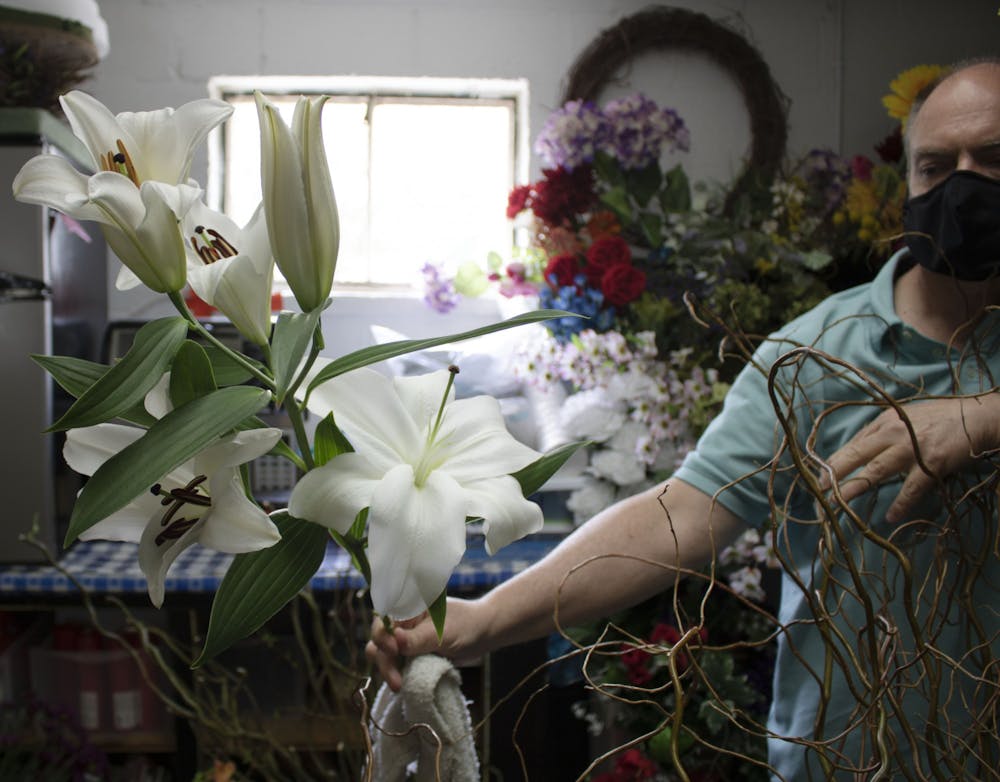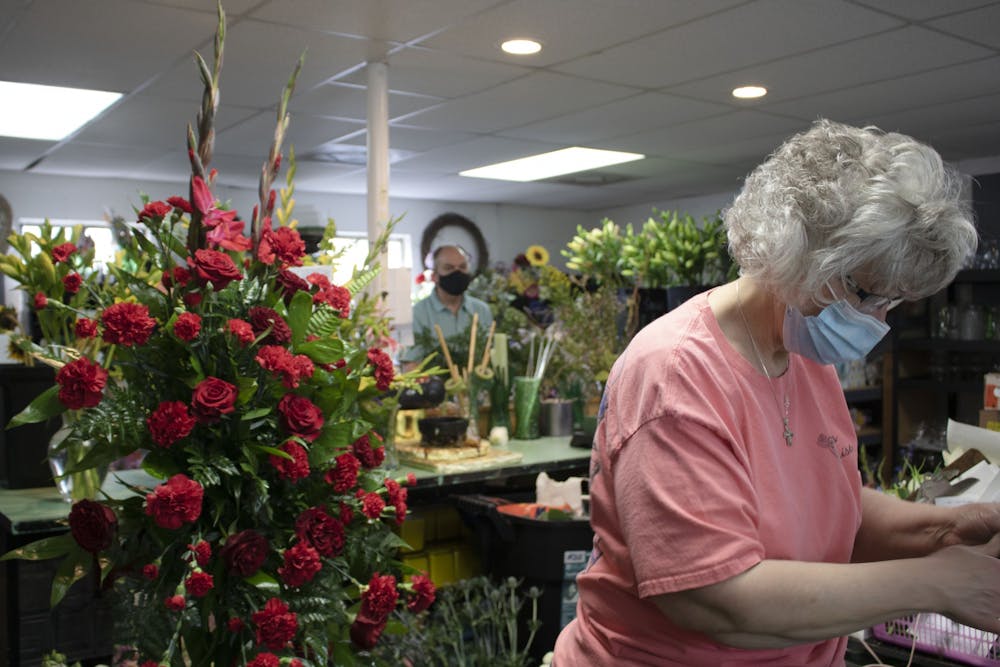On a warm Friday afternoon in April, business inside Roxie’s Florist was in full bloom. Within the store’s gray walls, the entire staff snipped a colorful array of flowers, greenery and bows. Sherri Pass, a Roxie’s employee, hurriedly assembled a funeral arrangement, hoping to finish up before nightfall.
“We were just thinking this week that maybe things were starting to slow down a bit, but then the weekend hit,” Pass said. “We have two casket sprays and a small wedding on top of the funeral work, so that makes it even busier.”
Local florists in the Burlington area, including Roxie’s, are experiencing an increase in demand as events resume. However, the surge in business has left the florist industry facing a major supply shortage.
Longtime Roxie’s employee Wendy Grady said the pandemic didn’t decrease the demand, but it did decrease the supply.
“We’ve had more and more difficulty getting all the flowers that we want, getting the plants that we want and getting materials like vases and baskets,” Grady said. “COVID has affected the floral industry because there weren’t as many people planting flowers, there weren’t as many people to harvest the flowers and they planted less flowers.”
Local florists order their flowers, plants and other materials mostly from wholesalers or farmers.
Carolyn Renfrow, secretary and treasurer of Cyn-Mar Wholesale Florist & Greenhouse located in Pine Level, NC said many of their flowers and supplies come from outside of the United States. Fresh-cut flowers and plants are grown in South America, while baskets and pots are imported from China.
Renfrow said the industry’s reliance on imported floral materials has made acquiring these items now harder than in the pre-pandemic past.
“With Ecuador and these other countries where things were shut down for so long, people were out of work and they weren’t able to replant,” Renfrow said. “We are seeing a big shortage right now on cut flowers. It’s really hard to get, and the prices have really gone up.”
The shortage impacts the florists at the local level, Renfrow said, as wholesalers may no longer be able to provide every flower or material florists might need.
“You order something, and it may be six weeks before you get it, or it may be two months — you just never know,” Renfrow said. “And if I don’t have it, there’s a good chance another wholesaler isn’t going to have it. There’s just a shortage across the board.”
Several local florists receive products from the same suppliers and wholesalers, which is making the shortage even more difficult. Filo’s Creation Florist owner Filo Sousa-Rosa said another supply issue arises from the amount of time and communication needed to fulfill international flower orders.
“We need to place orders months ahead and as the orders come in, we figure, ‘OK, I’m going to need 500 more roses or 250 more,’” Sousa-Rosa said. “[Vendors] have to be prepared to take our big orders because they have to order from South America, where most of these flowers come from.”
In an attempt to navigate the shortage from international growers, Filo’s and Roxie’s florists have tried to buy locally grown flowers and fresh-cut flowers from California.
The decrease in floral supplies is also in response to the increasing demand.
“Business has increased, and I just think it’s because in hard times people send flowers and plants,” Renfrow said. “They make you feel happy.”
After over a year of quarantine and limited interaction with family and friends, people are wanting to connect again, and part of expressing that missed connection is through flowers, according to Sousa-Rosa.
She also said this year’s Valentine’s Day and Easter sales were some of her highest ever.
The recent increase in weddings — as many were postponed or canceled due to the pandemic — is also responsible for the influx in floral demand. Grady said Roxie’s had to complete three wedding orders in one day as the weddings were previously paid and scheduled for different dates but were all renewed for the same day.
At Roxie’s Florist, Pass often assembles wedding floral arrangements and said “weddings are something that have definitely picked up, for sure, because no one could do anything last year.”
Funerals are also contributing to the strain on florists’ supply.
“Last year, people were not buying flowers to put on their parent’s graves,” Sousa-Rosa said. “But this year, everybody started to put flowers on their parents’ graves or their loved ones.”
The increase in funeral flower arrangements, Grady said, is pandemic related. As of April 9, there have been 252 COVID-related deaths in Alamance County since the pandemic began, according to the North Carolina Department of Health and Human Services.
“No doubt about it, we did a lot of funeral flowers, and they’re still coming.” Grady said.
Roxie’s Florist was one of the few local florist shops that stayed open throughout the entire pandemic. Grady said she immediately requested Essential Business and Operation Designation from the state of North Carolina, and it took a few days to get a response and certification that her business was considered essential and thus not required to cease operation.
“We have not lost any business,” Grady said. “Unfortunately, there were a lot more funerals that we provided flowers for — lots of ‘get well,’ lots of ‘thinking of you,’ lots of ‘happy birthdays.’ We stayed busy.”

An employee at Roxie’s Florist in Burlington finalize an array of sold flower bouquets.
Grady said navigating the supply issue while still trying to please customers has been a challenge.
“We’re really having to struggle to talk [customers] through an order, and tell them what I might have to change,” Grady said. “A lot of people want exactly what they see in a picture and it’s very difficult sometimes.
Some customer’s orders and envisioned floral arrangements have to be adjusted. Grady said Roxie’s has been using their “professional purview” to make necessary changes.
“Some people want something very specific — it might’ve been a specific pink rose that they wanted — and you can’t do it. We had to get something different,” Grady said. “I’m just hoping I can sway them to get something to enjoy longer than a cut flower arrangement if that shortage prevails.”
In some cases, there is little that the florists can do if they don’t have the exact flower, color or plant a customer wants.
“You make it with what you got, and if you don’t have it, you don’t have it,” Sousa-Rosa said. “There’s nothing we can do.”
Looking forward, Mother’s Day is less than a month away, and floral wholesalers and local florists are concerned about how the supply shortage will affect one of their typically busiest holidays.
“With the cut flowers, we are going to be seeing this [shortage] all through the summer, and it’s not going to get much better until the fall, which is going to be a challenge,” Renfrow said. “Especially with Mother’s Day coming up, I think it’s going to be a challenge to get through the summer.”
Grady is hopeful that the increase in demand will encourage a more plentiful supply for the upcoming season.
“I tell my vendors all the time, ‘but I need this, but I need that,’ so I’m hoping that they will understand it’s okay to get stuff, don’t hold back, get it, because there are other people like me that need these plants or these flowers,” Grady said.


